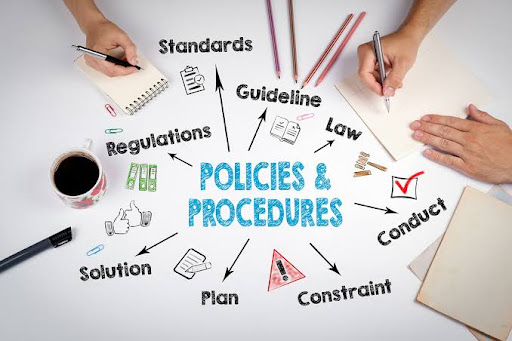Policies are what make organizations “organized”.
How a company’s leadership conducts its operations is critical for employee motivation, resolving problems, and setting goals. Considering companies consist of people, workers must understand what their bosses believe in and stand for and what it means to be a part of the organization.
Having the correct corporate rules in place shows employees that you are willing to give a pleasant working environment. According to recent HR data, 51% of employees believe employee benefits are essential to talent retention. Your employees are curious about how corporate policies and procedures affect their lives.
Policies and procedures designed to defend worker rights simultaneously serve to preserve the company’s commercial interests. Policies also promote customer service by giving a mission and vision for the company’s short- and long-term goals. Suffice it to say that establishing the most forward-thinking corporate rules will provide the groundwork for an excellent company culture.
Let’s begin!
Online parking system: Benefits and why you should invest in one

An online parking system‘s principal purpose is to aid individuals in handling their parking operations. It has automatic entry gates, an independent ticketing system, and a range of other features or add-ons to accomplish this. Its creation was in response to the broken system connected with traditional parking systems.
The following are some of the many reasons why you should invest in an online parking software right now:
-
Offers better experience
The more comfort you provide your employees, the happier they will be. Improving parking lot management might work wonders if you want to keep your staff pleased.
Using a parking management system eliminates the need for individuals to wait in huge lines merely to park their cars.
A system like this also provides consumers with a variety of payment options. Your employees will not have to wait in lines to access or depart their parking space because the system is ticketless and uses automated vehicle recognition.
-
Enhanced security
The security component of parking is critical for these parking management systems. Car theft has always been a global issue in many parking lots. As a result, these systems provide solutions that include car theft dynamics and assist car park managers in understanding the position and coverage of these systems.
Managing a parking system was a time-consuming operation that had to be done by hand until recently. However, automation software has made it easier to operate parking systems. Numerous cities and lot owners have benefited from implementing automated parking systems, making it more straightforward for customers to locate parking.
-
Saves time
One of the purposes of an online parking system is to decrease the time and effort necessary to find a parking place.
As a result, a computerized parking system makes parking a pleasant experience for you and your employees. Everything you need to know is only a click away! As a result of this practice, there are fewer accidents, disputes, and dangers of being late for work.
Tips on how to manage your team

Organizations strive to enhance and produce innovative products and services using work teams’ combined expertise, knowledge, and varied opinion. These teams’ success is vital in achieving corporate plans and goals.
If you’re feeling overwhelmed by the responsibility of managing your team, here are a few tried-and-true strategies for getting the most out of the people you lead:
-
Get goal-oriented.
Successful teams utilize a clear goal to guide their decisions and strive to achieve team objectives.
Every organization should document its vision and mission statement to establish team boundaries while clarifying team direction. They should create the blueprint early in the team’s formation to increase comprehension and buy-in to the group project.
The team understands what they are attempting to do and collaborates to ensure that what they set out to do is done well and with a precise measure of success.
Additionally, providing precise metrics lets the team know that their efforts were successful.
-
Establish vibrant communication channels
Effective communication is necessary for managing the team successfully and achieving the team’s full potential.
Regular one-on-one and successful team meetings are excellent for maintaining continuous and open communication. Also, it creates a standard platform for team members to share anything that comes to mind. It’s also an excellent opportunity to let them know how essential their job is to you and the company.
Listening is, of course, a vital element of communication. Encourage team conversations in which everyone participates. Always ask if there is anything they would want to raise and discuss in one-on-one meetings, and allow for Q&A at the end of presentations.
-
Know your team
Make out time to get to know your staff and cultivate camaraderie. In this scenario, acquiring intelligence entails discovering what determines your team’s strengths and skills.
All outstanding leaders know what buttons to push and when to push them. They are professionals at bringing out the best in those around them. They are equally adept at matching distinct areas of subject matter knowledge and capabilities to solve issues and explore new solutions.
Knowing your team ultimately implies that you have taken the time to learn how they think and what it takes to push them to go above and beyond their routine tasks.
5 Company policies to consider when managing your team

Company policies and procedures are put in place to create the standards of behaviour inside a company, detailing the duties of both workers and employers. The administration of firm policy and procedures aims to preserve employees’ rights and employers’ commercial interests.
Depending on the needs of the company, various policies and procedures set regulations for employee behaviour, attendance, dress code, privacy, and other areas linked to the terms and circumstances of employment.
These policies will guarantee a more effective way of managing your team:
-
Employee code of conduct policy
Employee code of conduct is the foundation of several policies since it specifies the fundamental principles of corporate behaviour.
An employee conduct policy specifies how you want your staff to act. It often covers topics like a suitable dress code, social media and cell phone usage, acceptable professional conduct, and social standards. Your employee code of conduct policy should represent your organization’s mission, fundamental values, and culture.
Furthermore, a code of conduct should explain precisely how workers should respond if they see a breach of the applicable regulations and the repercussions of wrongdoing. The rules must be simple and easy to understand. When employees need clarification about appropriate behaviour, they can consult them.
-
Equality policy
Any organization with an equal opportunity policy prohibits discriminating against workers or job candidates based on a “protected feature” (gender, age, race, etc.). It is essential for rules on non-discrimination, anti-harassment, workplace violence, and diversity.
It also benefits your organization in two ways: first, it broadens the pool of candidates from which to select the best candidate for each job, and second, it promotes a fair atmosphere in which workers may coexist, work, and grow. Putting it in writing sends a clear message to all employees that equal opportunity is a reality at your organization.
-
Remote work policy
A remote work policy is a collection of instructions that specify how and when workers can work from home. A remote work policy also addresses who is qualified to work remotely, communication expectations, time-tracking procedures, data security standards, legal issues, and other topics.
Remote work regulations can be interim or continuous, and they can apply to full-time and part-time workers working from home.
With a defined working remote policy, there is certainty, understanding, and increased productivity. That is why it is critical to have a work-from-home policy that establishes expectations for your workers, keeps them on track when working from home, and aids in the prevention of any potential legal issues.
-
Health and safety policy
A health and safety policy describes the method to be followed, employee duties to be met, and minimal working conditions to guarantee that workers work in a safe setting.
A health and safety policy should also include information such as what to do if a fire or how to report accidents or work-related injuries. The policy would also stipulate whether or not the employee should wear safety equipment/protective gear and the specifics of any safety training supplied to employees.
-
Employee compensation and benefits policy
Employee benefits are non-cash remuneration provided to employees. These perks are provided to employees in addition to their salary and earnings. They are also known as fringe benefits and are supplied to attract and retain personnel.
Companies must specify what their workers may anticipate regarding paid vacation, healthcare coverage, paternity/maternity, medical, and sick leave. Employers and workers will hold each other accountable in this way.
Final thoughts
Although each company’s handbook will be unique depending on how internal and external procedures are managed, certain sections need to be included. A well-structured corporate policy statement guides you and your staff on how to conduct themselves.
Company policies should clearly explain a company’s basic norms and values. It should also be utilized as onboarding material when welcoming new team members since it communicates the overarching expectations and standards in your organization.




